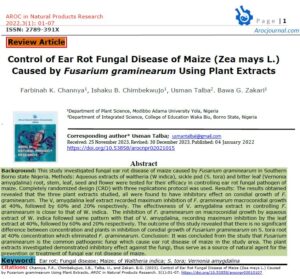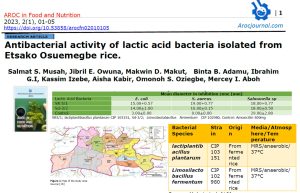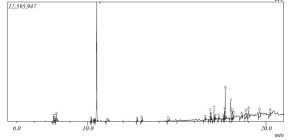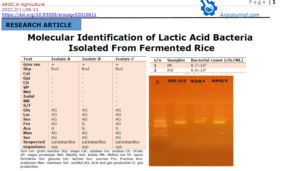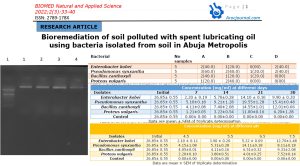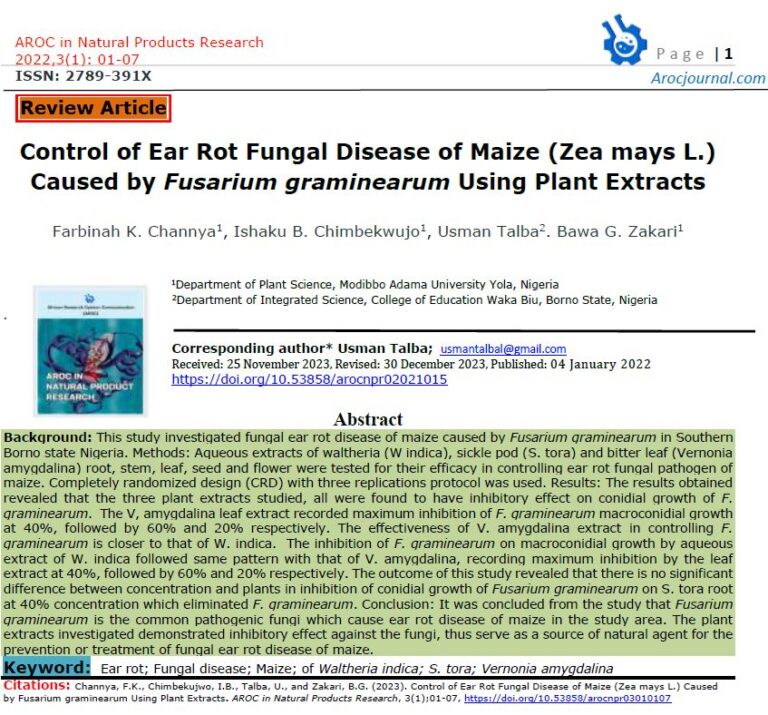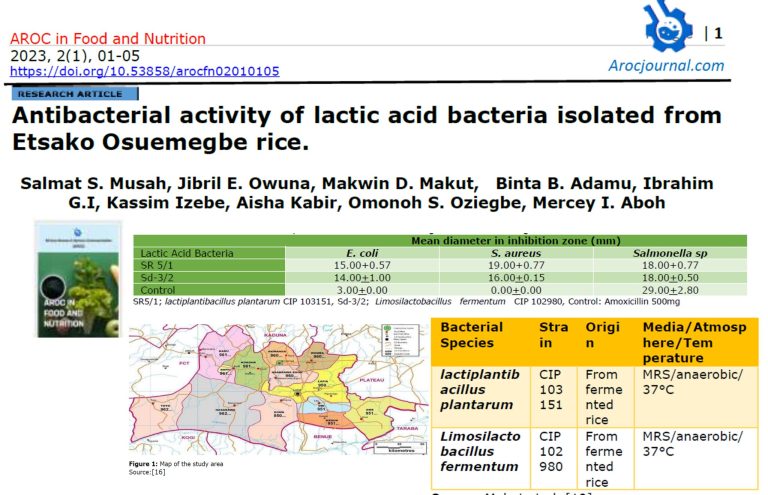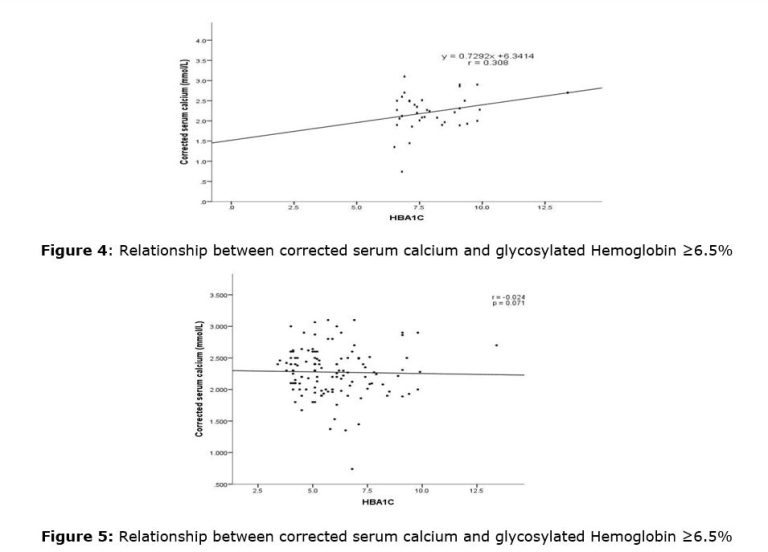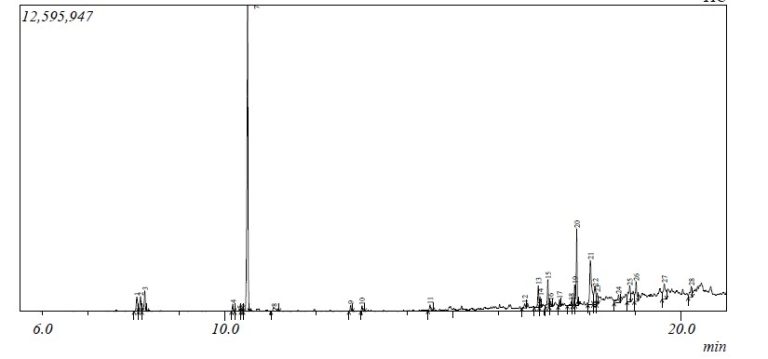1.0 Introduction
Medicinal plants are of great importance to the health of individuals and communities [1]. The medicinal value of these plants lies in some chemical substances that produce a definite physiological action on the human body [2-4].
The medicinal values of plants have assumed a more important dimension in the past few decades owing largely to the discovery that extracts from plants contain not only minerals and primary metabolites, but also a diverse array of secondary metabolites with various biological properties [5-8]. The most important of these bioactive constituents of plants are alkaloids, tannins, flavonoids and phenolic compounds [9].
Khaya senegalensis, locally known as Mahogany it is one of the most economically important forest tree species. That is widely distributed in the east, central and west Africa subregions [10]. It can grow up to 15-30m in height and 1m in diameter. The plant is commonly used by the Nupes of Niger State of Nigeria and some other parts of Africa. Khaya senegalensis which contains scopoletin, scoparone, limonoid, bitter principle, tannins, saponins and sterol has its stem bark and leaves used for the treatment of several human and animal diseases [11]. Such uses include as an antisickling agent while the bark and seeds have been reported to be active against Plasmodium falciparum in vitro. It has also been used as an anthelmintic, emetic, emmenagogue and in jaundice treatment [12]. These plant extracts have been documented to exhibit anti-inflammatory, anti-microbial, anthelmintic, anti-malarial and anti-oxidant properties.
1.1 The Genus Khaya
The family Meliaceae, comprised of 51 genera and approximately1400 species, is found primarily in pantropical regions [13]. Many large trees in this family are well-known for their high-quality timber, especially those in the genera; Agliaia, Aphanamixis, Azadirachta, Carapa, Cedrela, Chukrasis, Dysoxylum, Entandrophragma, Guarea, Khaya, Melia, Soymida, Swietenia, and Trichilia [14]. The most common commercial genus of this family in Africa is Khaya (African mahogany), which contains only 5 species namely; K. anthotheca, K. grandifoliola, K. ivorensis, K. nyasica, and K. senegalensis, found in all over the world. All the species of the Khaya genus are well known for their high-quality hardwood, which is resistant to insect and fungal attacks [12].
2.0 Habitat and distribution
Khaya senegalensis is a medicinal plant commonly used by the Nupes of Niger State of Nigeria and some other parts of Africa. Khaya senegalensis is also known as Dry zone mahogany (English) Hay (Senegal), Madotchi, Farrey (Niger), Aganwo, Madaci Ono (Nigeria), Jala (Cameroun) Mahogen (Togo)and kuka (Burkina Faso) [12]. Khaya senegalensis favourable habitats are those in wet soils, deep; alluvial; the edge of streams and non-flooded lowlands. It also accommodates dry or superficial or lateritic stations when rainfall is between 650-1300 mm during 4-7 months [15]. It inhabits Sudanese and Sudanese-Guinean regions. It is abundant in the woodlands of most countries in the Guinea Gulf (Cameroon, Gabon, Nigeria, Benin, Togo, Ivory Coast, Guinea, Guinea Bissau, Gambia and Senegal) [10]
2.1 Botanical Description
Khaya Senegalensis is a deciduous evergreen tree 15-30m high up to 1m in diameter, with a clean bole to 8 – 16m buttresses not prominent or absent, bark dark grey, with small, thin, reddish tinged scales, slash dark pink to bright crimson, exuding a red sap leaves alternate, compound, stipules absent, petiole and rachis 13-33cm long leaflet 3-4 (max: 7) usually opposite pairs, oblong to narrowly oblong-elliptic, 4-12 x 2-5cm, apex acute to shortly acuminate, base rounded, pale green, lateral nerves, 8 – 16 petiolules about 3.5cm long [16]. In fluorescence, a lax much branched axillary panicle up to 17cm long flower tetramerous, monoecious but with a well-developed vestige of those of the opposite sex with very little external difference between sexes [16]. The calyx is pale green lobed almost to the base lobes subcircular about 1 x 1 mm, imbricate petals cream, free oblong-ovate 4 x 2.5mm contorted in the bud, orange disc around the ovary fruit an upright almost spherical. Seeds brown 6 or more per cell broadly transversely ellipsoid to flat, about 25 x 18mm, margins narrowly winged [17].
2.2 Scientific Classification
Kingdom Plantae
Subkingdom Viridaeplantae
Division Tracheophyta
Subdivision Spermatophytina
Infradivision Angiospermae
Class Magnoliopsida
Suborder Rosanae
Order sapindales
Familly maliaceae
Genus khaya
Species Senegalensis

 Figure 1; The (A) Treee (B) fruit, (C) flower, (D) stem, and (E) leaves
Figure 1; The (A) Treee (B) fruit, (C) flower, (D) stem, and (E) leaves2.3 Ethno-medicinal uses of Khaya senegalensis
Khaya senegalensis, which is a timber tree in the family Meliaceae, has been used traditionally for treating several ailments including malaria, rheumatism, fever and back pain in Africa [18]. The crude extracts from different parts of these tree species have been reported to exhibit anti-inflammatory, antioxidative and anti-diabetic, and anti-hypertensive activities among others, which justify their traditional use in the treatment of some ailments [19].
Khaya senegalensis is one of the most popularly known medicinal meliaceous plants that are used traditionally to treat and manage various ailments [20]. The decoction of its stem bark is commonly used as a bitter tonic in folk and popular medicines for malaria, fever, mucous diarrhoea, and venereal diseases as well as for an anthelmintic and a taeniacide remedy [21]. The stem bark extracts and the chemical constituent profile have been the subject of extensive phytochemical and pharmacological investigations since the 1960s.
2.4 Chemical constituents of Khaya senegalensis
Analysis of Mahogany (Khaya senegalensis (Desr.) Juss. A.), indigenous to Sudan, for its proximate composition, minerals, fatty acids, total soluble phenolics, phenolic constituents and tocopherols revealed that the crude fat was 53% in seed kernel and 13% in the coat. Oleic was the major fatty acid in seed kernel (79%) and coat (73%). Total soluble phenolics were 2620 mg GAE/100 g DW in the seed coat and 920 mg GAE/100 g DW in the kernel. The amount of δ-tocopherol was 36 mg/100 g DW in the seed kernel and 10 mg/100 g DW in the coat [22].
Two dimeric flavonoids, as well as 2,6-dihydroxy-p-benzoquinone, b-sitosterol, and 3-O-glucose-b-sitosterol, catechin, tannins, saponins, polysaccharides, and coumarins [23], with immunostimulating activity, have been isolated from the extracts of its stem bark. About 45 limonoids isolated from the leaf, seed, and stem bark of this plant constitute the bitter principles of the plant extracts [24]. Furthermore, some limonoids exhibited feeding deterrent and growth inhibitory properties and anti-feeding, anti-fungal [25], and anti-sickling activities [26]
Khaya senegalensis is a very popular tree, used for high-class furniture, joinery, building and construction purposes, and recommended for utilization purposes for which surface quality is of high importance [27]. The species has also high traditional medicinal values and is used as an ornamental tree for gardens and avenues. Despite its importance, the species is only limited incorporated in a forestation programmer. This is mainly because, like most tropical forest tree species, studies on silviculture of the species are incomplete [22].
The heavy metals analysis of K. senegalensis revealed that cadmium, cobalt and lead were not detected, while copper (0.07±0.02 mg/kg), nickel (0.03±0.007 mg/kg), mercury (0.03±0.005 mg/kg), manganese (0.03±0.006 mg/kg), chromium (0.02±0.004 mg/kg) and arsenic (0.21±0.06 mg/kg) were detected [28]
2.5 Biological activities of Khaya senegalensis
Five limonoids (methylangolensate, gedunin, 1-deacetylkhivorin, 7-deacetylkhivorin and 6-acetyl-swietenolide) isolated from Khaya species demonstrated anti-malaria activities against the chloroquine-resistant strain of P. falciparum with IC50 values range of 1 μg/ml and10 μg/ml [29]. Similarly, the antimalarial efficacy of two limonoids (anthotechol and gedunin) from the “whole-plant” of Khaya species was also reported against the W2-strain of P. falciparum with IC50 values of 1.4 μM and 0.17 μM [30].
Makut et al. [31]. evaluated the anti-microbial activities of K. senegalensis The antimicrobial susceptibility test showed that S. aureus, S. feacalis and C. albicans were susceptible to both the leaf and bark extracts, while E. coli was not. The extracts were also found to be bactericidal to S. aureus and S. feacalis, and fungicidal to C. albicans. This study demonstrates the potentials of K. senegalensis as a source of antimicrobials that could be harnessed for use in the Health Care Delivery process [31].
Antioxidant analysis revealed that the acetone, ethanol and methanol extract of K. senegalensis exhibit 66.282%, 84.838%, and 85.921% scavenging ability respectively at 100µg/cm3 compared with 97.437% of the standard, ascorbic acid [32].
Marius et al. [33] reported the vermicidal and antispasmodic properties of the trunk bark and leaves of Khaya senegalensis A Juss (Meliaceae). The phytochemical screening of the extracts studied revealed the presence of chemical groups such as saponosides, tannins, flavonoids, etc., with variations in levels between the two parts of the plant. The lethal 50% oral dose of the extracts was greater than 5000 mg/kg. Inhibitory concentrations of aqueous macerates were 1.936 mg/mL for leaves and 0.975 mg/mL for trunk bark. These results would justify the efficacy and safety of plant extracts in the treatment of some intestinal parasitosis in traditional therapeutics [33].
2.6 Conclusion
The present review revealed that Khaya senegalensis is an important medicinal plant due to its traditional uses for the treatment of several diseases and the presence of many important bioactive compounds which have been implicated in the for various pharmacological properties of the plant. Further experimental studies are needed to fully validate the medicinal properties.
Authors Contributions: The work was conducted in collaboration of all authors. All authors read and approved the final version of the manuscript
Conflicts of interest: The authors declare that they have no competing interests.
Acknowledgement: Nil.
References
1. Ahmad, T.; Shahabuddin. The Uses of Medicinal Plants in the Treatment of Diseases. EUROPEAN ACADEMIC RESEARCH 2013, 1, 1850-1853.
2. Arora, S.; Kaur, K.; Kaur, S. Indian medicinal plants as a reservoir of protective phytochemicals. Teratogenesis, carcinogenesis, and mutagenesis 2003, 23, 295-300.
3. Beck, S.; Mathison, H.; Todorov, T.; Calder, E.; Kopp, O.R. A review of medicinal uses and pharmacological activities of Tridax procumbens (L.). J. Plant Stud 2018, 10.
4. Lawal, B.; Sani, S.; Onikanni, A.S.; Ibrahim, Y.O.; Agboola, A.R.; Lukman, H.Y.; Olawale, F.; Jigam, A.A.; Batiha, G.E.-S.; Babalola, S.B., et al. Preclinical anti-inflammatory and antioxidant effects of Azanza garckeana in STZ-induced glycemic-impaired rats, and pharmacoinformatics of it major phytoconstituents. Biomedicine & Pharmacotherapy 2022, 152, 113196, doi:https://doi.org/10.1016/j.biopha.2022.113196.
5. Krog, M.; Falcão, M.P.; Olsen, C.S. Medicinal plant markets and trade in Maputo, Mozambique; Forest & Landscape Denmark (FLD): 2006.
6. Lawal, B.; Shittu, O.K.; Oibiokpa, F.I.; Berinyuy, E.B.; Mohammed, H. African natural products with potential antioxidants and hepatoprotectives properties: a review. Clinical Phytoscience 2017, 2, 1-66.
7. Lawal, B.; Shittu, O.K.; Kabiru, A.Y.; Jigam, A.A.; Umar, M.B.; Berinyuy, E.B.; Alozieuwa, B.U. Potential antimalarials from African natural products: A reviw. Journal of intercultural ethnopharmacology 2015, 4, 318.
8. Bashir, L.; Shittu, O.; Sani, S.; Busari, M.; Adeniyi, K. African natural products with potential antitrypanosoma properties: A review. Int J Biochem Res Rev 2015, 7, 45-79.
9. Adesina, D.A.; Adefolalu, S.F.; Jigam, A.A.; Lawal, B. Antiplasmodial effect and sub-acute toxicity of alkaloid, flavonoid and phenolic extracts of Sida acuta leaf on Plasmodium berghei-infected animals. Journal of Taibah University for Science 2020, 14, 943-953, doi:10.1080/16583655.2020.1790912.
10. Sokpon, N.; Ouinsavi, C. Utilisations du Khaya senegalensis en médecine traditionnelle au Bénin. Revue Méd. Pharm. Afr 2002, 16, 9-19.
11. Ibrahim, J.A.; Ayodele, E.A.; Jegede, A.I.; Kunle, Y.F. Comparative studies on Khaya. A. Juss (Meliaceae) in Nigeria. African Journal of Biotechnology 2006, 5.
12. Olatunji, T.L.; Odebunmi, C.A.; Adetunji, A.E. Biological activities of limonoids in the Genus Khaya (Meliaceae): a review. Future Journal of Pharmaceutical Sciences 2021, 7, 1-16.
13. Aspinall, G.; Hirst, E.; Matheson, N. 206. Plant gums of the genus Khaya. The structure of Khaya grandifolia gum. Journal of the Chemical Society (Resumed) 1956, 989-997.
14. Aspinall, G.; Bhattacharjee, A. Plant gums of the genus Khaya. Part IV. Major component of Khaya ivorensis gum. Journal of the Chemical Society C: Organic 1970, 361-365.
15. Gaoue, O.G.; Ticktin, T. Impacts of bark and foliage harvest on Khaya senegalensis (Meliaceae) reproductive performance in Benin. Journal of Applied Ecology 2008, 45, 34-40.
16. Lemes, M.R.; Esashika, T.; Gaoue, O.G. Microsatellites for mahoganies: Twelve new loci for Swietenia macrophylla and its high transferability to Khaya senegalensis. American Journal of Botany 2011, 98, e207-e209.
17. Lawal, A.; Adekunle, V.; Onokpise, O. Biosystematics, morphological variability and status of the Genus Khaya in South West Nigeria. Applied Tropical Agriculture 2016, 21, 159-166.
18. Zhou, M.-M.; Zhang, W.-Y.; Li, R.-J.; Guo, C.; Wei, S.-S.; Tian, X.-M.; Luo, J.; Kong, L.-Y. Anti-inflammatory activity of Khayandirobilide A from Khaya senegalensis via NF-κB, AP-1 and p38 MAPK/Nrf2/HO-1 signaling pathways in lipopolysaccharide-stimulated RAW 264.7 and BV-2 cells. Phytomedicine 2018, 42, 152-163, doi:https://doi.org/10.1016/j.phymed.2018.03.016.
19. Olatunji, T.L.; Odebunmi, C.A.; Adetunji, A.E. Biological activities of limonoids in the Genus Khaya (Meliaceae): a review. Future Journal of Pharmaceutical Sciences 2021, 7, 74, doi:10.1186/s43094-021-00197-4.
20. Mahmud, H.; Oyi, A.; Allagh, T. Studies on some physicochemical properties of Khaya senegalensis gum. Nigerian Journal of Pharmaceutical Sciences 2008, 7, 146-152.
21. Iwu, M.M. Pharmacognostical profile of selected medicinal plants. In Handbook of African Medicinal Plants, CRC Press: 2014; pp. 125-380.
22. Salih, N.K.-E.M.; Yahia, E.M. Khaya senegalensis seed: chemical characterization and potential uses. Journal of chemical and pharmaceutical research 2015, 7, 409-415.
23. Kayser, O.; Abreu, P. Antileishmania and immunostimulating activities of two dimeric proanthocyanidins from Khaya senegalensis. Pharmaceutical Biology 2001, 39, 284-288.
24. Yuan, T.; Zhang, C.-R.; Yang, S.-P.; Yue, J.-M. Limonoids and triterpenoids from Khaya senegalensis. Journal of natural products 2010, 73, 669-674.
25. Abdelgaleil, S.A.; Iwagawa, T.; Doe, M.; Nakatani, M. Antifungal limonoids from the fruits of Khaya senegalensis. Fitoterapia 2004, 75, 566-572.
26. Fall, A.B.; Vanhaelen-Fastré, R.; Vanhaelen, M.; Lo, I.; Toppet, M.; Ferster, A.; Fondu, P. In vitro antisickling activity of a rearranged limonoid isolated from Khaya senegalensis. Planta medica 1999, 65, 209-212.
27. Arnold, R. Khaya senegalensis: current use from its natural range and its potential in Sri Lanka and elsewhere in Asia. Prospects for high-value hardwood timber plantations in the ‘dry’tropics of northern Australia [CD-ROM]. Gympie: Private Forestry North Queensland Association Inc 2004.
28. Ali, A.; Abubakar, U.; Suleiman, A.; Adeleke, A.; Abdulrazak, A.; Sa’adatu, A. Phytochemical, Acute Toxicity and Heavy Metals Evaluation of Khaya senegalensis (Desr.) A. Juss (Meliaceae) Stem Bark.
29. Bickii, J.; Njifutie, N.; Ayafor Foyere, J.; Basco, L.K.; Ringwald, P. In vitro antimalarial activity of limonoids from Khaya grandifoliola C.D.C. (Meliaceae). Journal of Ethnopharmacology 2000, 69, 27-33, doi:https://doi.org/10.1016/S0378-8741(99)00117-8.
30. Lee, S.-E.; Kim, M.-R.; Kim, J.-H.; Takeoka, G.R.; Kim, T.-W.; Park, B.-S. Antimalarial activity of anthothecol derived from Khaya anthotheca (Meliaceae). Phytomedicine 2008, 15, 533-535, doi:https://doi.org/10.1016/j.phymed.2007.08.001.
31. Makut, M.; Gyar, S.; Pennap, G.; Anthony, P. Phytochemical screening and antimicrobial activity of the ethanolic and methanolic extracts of the leaf and bark of Khaya senegalensis. African Journal of Biotechnology 2008, 7.
32. Ukekpe, U.; Okpashi, V. Phytochemical Screening and Antioxidant properties of Stem bark of Khaya senegalensis (Dry-zone Mahogany). Journal of Chemical Society of Nigeria 2019, 44.
33. Marius, L.; Salfo, O.; Noufou, O.; Lazare, B.; Laurent, B.A.G.; Benjamin, O.; Aristide, T.; Sylvin, O.; Pierre, G.I. Vermicides activities of trunk barks and leaves of Khaya senegalensis A. Juss (Meliaceae). World Journal of Advanced Research and Reviews 2020, 5, 064-073.


